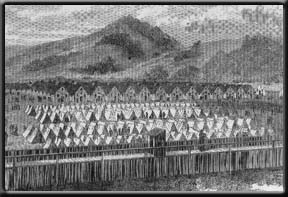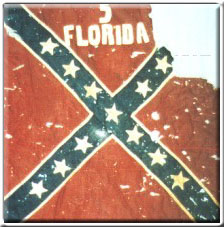

![]()
![]()
My ancestor, Henry Joseph
Hale, was the son of Benjamin and Martha Hale, early settlers of Leon County,
FL. Benjamin was from North Carolina and apparently moved to South Carolina
where he married Martha, a South Carolina native. It appears Ben was a widower
and already had several children at the time of his marriage to Martha. Henry
Joseph was the first child of this second marriage.
The War of Aggression began April of 1861 with the capture of Fort Sumter.
Henry's military records indicate he enlisted 12/30/61 at Monticello. He was
assigned to the 5th FL Infantry, Co A. On September 17, 1862, he was severely
wounded at the Battle of Sharpsburg (Antietam) in Maryland. He was one of 11,000
Confederate and 12,500 Union casualties that day on Antietam Creek---making it
the bloodiest day of the entire war. The wounded Henry was captured but was
paroled eight days later and hospitalized. He was furloughed but returned to his
unit late in '63.
The 5th FL Infantry spent early 1864 defending Virginia's hallowed soil from
Grant and his army and participated in the Battle of Gettysburg. The two armies fought for days in the Wilderness and clashed
again at Spotsylvania Courthouse, a tiny village at a vital crossroads on the
way to Richmond. Here Henry was captured, May 12, 1864.
From Spotsylvania the captives were marched to Point Lookout, where they were
held until July. They were then loaded in the hold of a government transport
ship and taken to New York. From New York City, they traveled by train to Elmira
Prison. Formerly a Union rendezvous camp built to shelter 3,000 soldiers, it had
been converted to a prison for 5,000 by building a twelve-foot-high stockade
fence around it. Ultimately, the "prison"- I prefer to call it a death
camp- would be filled with over 10, 000 Confederate prisoners. "A more
unsanitary spot could not have been chosen. A one-acre lagoon of stagnant water,
a backwash from the river, stood within the stockade and soon gave rise to
several epidemics." An Alabama soldier wrote after the war, "Elmira
was nearer Hades than I thought any place could be made by human cruelty."
("The Scourge of Elmira" by James I. Robertson, from the book Civil
War Prisons) The 24-32 percent death rate even exceeded that of the
notorious, and much more publicized (thanks to Atlanta scalawag T. Turner)
Andersonville.

Henry Joseph Hale died in Elmira Prison of chronic diarrhea September 20, 1864.
He is buried there in the prison cemetery far, far from home.
- - By the way, most of the above, with the exception of my own flourishes, I
plagiarized from a brilliant paper written by my dear mother. I wish I had the
space to print the paper here in it's entirety, but unfortunately I don't.
![]()

(5th Florida Infantry flag captured at Gettysburg)
Another g-g-great grandfather of mine was William A. Horton, b. 1830, Darlington Co., South Carolina. Regrettably, at this moment, I don't have a lot of information to put here about him, but my parents just made a trip to Fredricksburg where they found quite a bit of info on him, his participation in the Battle of Gettysburg, and even found his burial site! He is not on the muster rolls, but we have his other records, and I am waiting to learn more. I know, like Henry, he was in the 5th Florida Infantry, Co. E, called the Milton Light Infantry, and he was killed at the Battle of the Wilderness, May 6, 1864. You will be able to read more about this Confederate martyr, when I have a more complete picture to paint here.
Paul Hatch, brother of the
aforementioned Silas Hatch, was a member of the FL 8th Infantry Regiment, Com C.
He was mustered in May 13, 1862 under Captain David Lang. The 8th FL had already participated in the 2nd
Bull Run and soon after Paul's arrival, they fought at Antietam alongside the
5th FL, and following that they fought at Fredricksburg. By the summer of '63, Paul had
been promoted to Corporal, and while attached to Anderson's (Brig. Gen. George
T.T.) Division, in Longstreet's 1st Corps,
Army of Northern Virginia, the 8th FL joined the fray at Chancellorsville.
July 3rd, of 1863, Paul's direct participation in the war ended at Gettysburg.
The 8th FL Infantry had been reassigned to Lieutenant General A. P. Hill's 3rd
Corps, this time in Major General R. H. Anderson's Division. The man who had
promoted Paul had also been promoted. Now, Colonel David Lang was placed in
charge of Perry's Brigade, which included the 2nd, 5th, and 8th FL Infantry
regiments.
On the third day of battle, Lee ordered a frontal assault that would have to
cover over 1000 yds. of open ground, with a force spread almost a mile wide.
Major General George E. Pickett was to lead the southern wing of the attack,
while Anderson's Division, comprised of Brigadier General Cadmus M. Wilcox's
8th-11th and 14th Alabama Infantry regiments and Colonel David Lang's 2nd, 5th,
and 8th FL Infantry regiments were held back on Seminary Ridge as reinforcements
at the far southwestern end of the battlefield.

Col. David Lang
Some accuse A.P. Hill of costing the Confederacy the battle by, among
other things, not committing the two brigades at the same time as Pickett's men
made their infamous charge. Robert E. Lee felt differently and totally absolved
Hill of any wrong doing, but the fact remains the lack of the FL and AL brigades
who were positioned to charge the flank of the Union position on Little Round
Top, left Union Br. Gen. George J. Stannard, and his inexperienced Vermonters,
free to massacre Kemper's Brigade on Pickett's southern flank. After Kemper
himself had been severely wounded and the majority of his Virginians were
captured or killed, Lang and Wilcox were sent in to reinforce the exhausted
Virginians. The two brigades came in from their position near the Rose House,
too far south to be of any help to Kemper's Brigade, which sent them straight
past the Devil's Den, up the face of Little Round Top directly in front of
Stannard's Vermonters. They were met with a hail of fire from mere yards away,
and in a terrible yet brief exchange, three regiments of Florida infantrymen and
five regiments of Alabamians were almost completely decimated. Paul was
wounded in the fighting and captured, along with most of the remaining survivors of his company,
as the Vermonters finally left their cover in the rocks and charged down on the
battered Confederates. He was sent to
Ft. Delaware military prison for the remainder of the war.
I must also mention that Paul's and Silas' brother-in-law, William Slaughter,
had joined the FL 8th, Co. C, a couple days after Paul and had fought side by
side with Paul throughout the war. I only wish I knew more of what happened that
fateful Friday of July 3, 1863. What I do know is that Silas' and Paul's sister
became a widow during that awful battle, and one more Cracker was buried in
Northern soil, never to return to his beloved home.

Three famous, yet, unidentified
FL infantrymen captured at Gettysburg.
The 8th FL Infantry went on to fight in the Wilderness, at Spotsylvania Court
House, Cold Harbour, and eventually joined the Petersburg Siege. They were at
Appomatox in the end.
Paul and Silas eventually returned to their homes on the west coast of Florida,
and the town of Hatch Bend is named for their family.
![]()
©Ty Starkey, 1998-2001